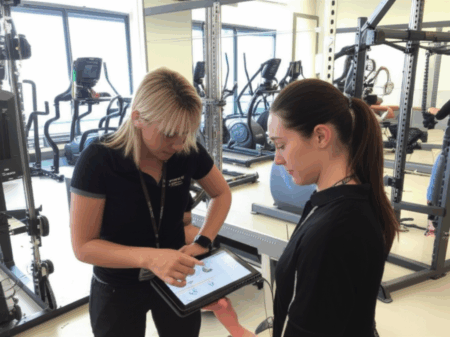The global fitness equipment market is poised for continued growth, driven by increasing health consciousness and technological advancements. Valued at $11.0 billion in 2017, projections estimate the market will reach $18.4 billion by 2033, reflecting a compound annual growth rate (CAGR) of 3.02% from 2024 to 2033. This expansion is fueled by evolving consumer behaviors, the integration of smart technology, and a growing emphasis on overall wellness.
Key Trends Shaping the Fitness Equipment Market
Several key trends are contributing to the growth and transformation of the fitness equipment industry.
The Rise of Smart Fitness
One of the most significant trends is the integration of smart technology into fitness equipment. By 2025, a vast majority of fitness equipment will feature digital connectivity, offering advanced capabilities such as:
- Real-time performance tracking: Equipment seamlessly captures workout metrics like repetitions, weight lifted, duration, heart rate, calories burned, and sleep patterns.
- Personalized workout recommendations: AI algorithms analyze user data to provide tailored exercise programs based on individual goals, fitness levels, and progress.
- Interactive training experiences: Users can access virtual personal trainers, AI-driven workout classes, and participate in group fitness activities through interactive screens and augmented reality (AR).
This Internet of Things (IoT) connectivity allows users to track their training history across different devices, promoting greater engagement and a deeper understanding of their fitness journey.
Home Fitness Revolution
The COVID-19 pandemic significantly accelerated the trend toward home-based fitness solutions. Even as gyms and fitness centers reopen, the convenience and flexibility of working out at home continue to appeal to many consumers. This has led to a surge in demand for:
- Compact equipment: Space-saving designs like foldable treadmills, multi-functional home gyms, and modular systems are gaining popularity.
- Connected fitness devices: Smart stationary bikes, treadmills, and rowing machines integrate with online platforms, offering live and on-demand workout classes, virtual coaching, and interactive community features.
- Innovative fitness products: Smart treadmills that monitor heart rate, speed and distance, often with compact, foldable designs, are becoming increasingly popular.
The Commercial Fitness Equipment Sector
While home fitness is booming, the commercial fitness equipment market is also experiencing rapid growth. This is driven by:
- Changing lifestyles and increasing health consciousness: More individuals recognize the importance of health, leading to a rise in gym memberships and fitness club attendance.
- Global urbanization: As cities grow, so does the demand for better fitness facilities, especially as disposable incomes rise.
- Rising obesity rates and stress levels: More people are turning to gyms and fitness clubs for exercise and stress relief.
- Bodybuilding and personal development trends: Younger generations are increasingly interested in bodybuilding, further boosting gym memberships.
Key Equipment Types and Their Growth
The fitness equipment market encompasses a wide range of products, each catering to specific fitness goals and preferences.
- Cardiovascular Training Equipment: This segment, which includes treadmills, ellipticals, and stationary bikes, currently leads the market due to its focus on heart health and overall fitness.
- Strength Training Equipment: This includes weight machines, free weights, and resistance training equipment. Interest in strength training has seen a significant increase, with consumer searches booming in recent years.
- Fitness Monitoring Equipment: Wearable devices like smartwatches and fitness trackers are increasingly integrated with fitness equipment, providing comprehensive data on workout performance.
Factors Driving Market Growth
Several key factors are driving the expansion of the fitness equipment market:
- Rising health awareness: Increasing awareness of the importance of physical activity and a healthy lifestyle is motivating more people to invest in fitness equipment.
- Prevalence of chronic diseases: The rising incidence of chronic conditions like cardiovascular disease, obesity, and diabetes is driving individuals to adopt fitness routines and utilize fitness equipment.
- Government initiatives: Public health initiatives aimed at promoting physical activity and reducing sedentary lifestyles are creating a supportive environment for the fitness industry.
- Corporate wellness programs: Companies are increasingly implementing wellness programs to improve employee health and productivity, often incorporating fitness equipment into the workplace.
- Technological advancements: The integration of smart technology, AI, and virtual reality is enhancing the fitness experience and attracting new users.
Regional Market Dynamics
The fitness equipment market exhibits diverse trends across different regions:
- North America: This region is a major market for fitness equipment, driven by high disposable incomes, a strong fitness culture, and a high prevalence of obesity.
- Europe: Similar to North America, Europe has a well-established fitness market with a growing emphasis on health and wellness.
- Asia-Pacific: This region is expected to experience rapid growth in the fitness equipment market, driven by increasing urbanization, rising disposable incomes, and a growing awareness of health and fitness. China stands out as the country with the highest revenue in the exercise equipment market worldwide.
- South America: The e-commerce sector’s strong expansion is intensifying the sales of home fitness equipment through online channels.
Key Players in the Fitness Equipment Market
The fitness equipment market is competitive, with several major companies vying for market share. Some of the leading players include:
- ICON Health & Fitness
- Johnson Health Tech
- Technogym
- Amer Sports
- Nautilus Inc.
- Peloton Interactive, Inc.
- Life Fitness
These companies are focusing on innovation, product development, and strategic partnerships to expand their market presence and cater to the evolving needs of consumers.
Challenges and Opportunities
While the fitness equipment market offers significant opportunities for growth, it also faces certain challenges:
- High cost of equipment: The price of advanced fitness equipment can be a barrier for some consumers.
- Competition from alternative fitness options: Consumers have a wide range of fitness options, including gym memberships, outdoor activities, and digital fitness programs.
- Changing consumer preferences: Fitness trends and consumer preferences are constantly evolving, requiring companies to adapt and innovate.
Despite these challenges, the fitness equipment market is poised for continued growth, driven by the increasing importance of health and wellness in today’s society. Companies that can offer innovative, affordable, and engaging fitness solutions will be well-positioned to succeed in this dynamic market.







